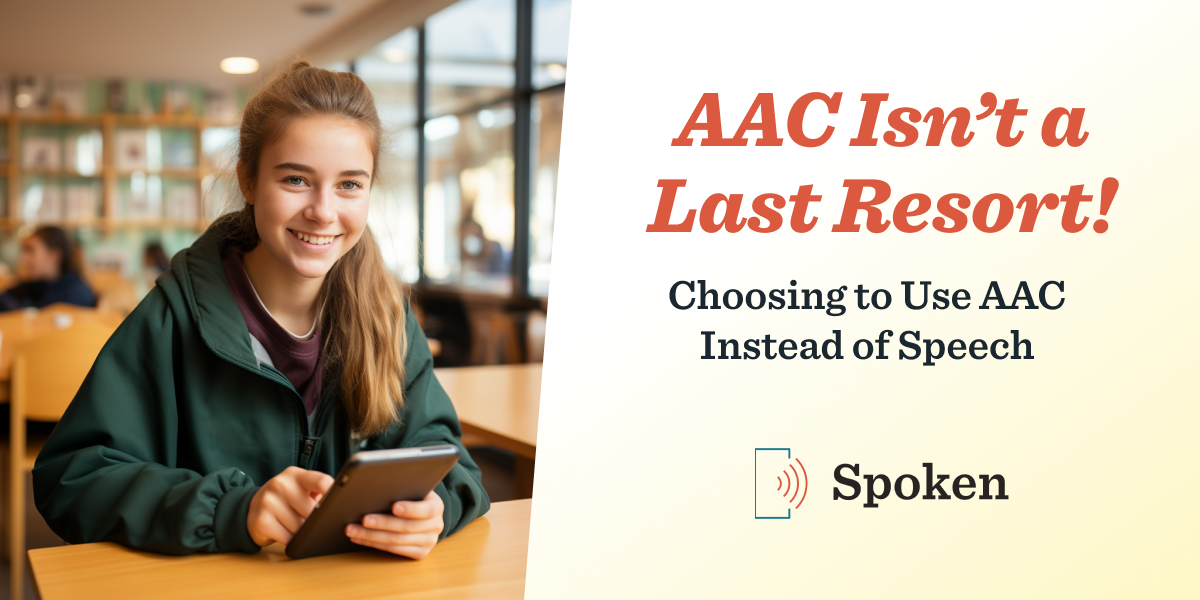AAC Isn’t a Last Resort: Choosing to Use AAC Instead of Speech

Augmentative and Alternative Communication (or AAC) technology is often viewed as a last resort, generally only being offered to those whose speech is limited, absent, or too difficult to understand. Yet, there are individuals who possess full speech but would still — or already do — benefit from AAC use. If you’re wondering how that could be, read on!
As you may know, many individuals on the autism spectrum are partially or fully nonverbal. For others, speech is an option, but it is both mentally and physically draining. In these cases, AAC is often overlooked as a solution, because it is rarely viewed as something one can elect to use unless they are reliant on it. However, AAC can and should be wielded proactively if the individual using it finds it more effective for communication than speech.
It’s important that we advocate for people to communicate in whatever way they find the most beneficial to themselves instead of pushing for speech. In doing so, we ensure that they are able to convey their thoughts in the way they intended and properly self-advocate. Conforming to societal norms should never take precedence over effective communication.
Why AAC Might Be a Better Choice
Much like autism itself, the verbal ability of autistic individuals can vary greatly; there is not a binary of “speaking” and “nonspeaking.” Some people have intermittent nonverbal episodes where they lose the ability to speak — referred to as “going nonverbal” — while others can speak consistently but feel burnt out if they force themselves to. It’s important to acknowledge this level of variation when considering how or why someone would benefit from AAC use. One person’s experience may be completely different from another’s. With that in mind, here are a few possibilities for why someone would choose to use AAC:
Reduced Cognitive Load and Preservation of Energy
In some cases, someone might have strong communication skills and the ability to speak, but they find it especially taxing to do so. Constructing spoken sentences on the spot involves multiple cognitive processes such as language formulation, sequencing, and coordinating motor movements. This can be mentally exhausting for some individuals, especially in fast-paced conversations or overwhelming situations. AAC tools allow these individuals to compose their thoughts at their own pace, alleviating the cognitive strain that comes with real-time speech production.
The cognitive load associated with verbal communication can be draining for some individuals, especially during lengthy or intense conversations. The energy expended on trying to maintain coherent speech and navigate social nuances can accumulate over time. AAC, being less energy-intensive, can offer a way to engage in communication without feeling depleted afterward.
Ability to Properly Convey Thoughts
Sometimes, difficulties with speech entail a disconnect between someone’s “mouthwords” and their actual thoughts. In these cases, the communicator may feel that they are unable to convey their thoughts properly, which can leave them feeling helpless and unable to self-advocate properly. The difficulty of speech may even increase as they become more frustrated. AAC offers a solution to this issue by giving these individuals the ability to say exactly what they mean.
Lowered Stress and Anxiety

Engaging in verbal communication, especially in social situations, can be anxiety-inducing for individuals with communication issues. The fear of not being understood, facing potential misunderstandings, or struggling to keep up with the flow of conversation can lead to heightened stress. AAC provides a buffer against these anxieties, offering a more controlled and predictable means of interaction.
Bolstered Confidence
If forced to communicate verbally at an inopportune moment, someone might stumble over their words or struggle to sound coherent, which can be embarrassing and ultimately lower their confidence in social situations. Conversely, feeling comfortable and less stressed during conversations can reshape their confidence. AAC can empower individuals to develop positive self-images as effective communicators.
Inclusivity in Conversations
Difficulty speaking can cause communication burnout and a lack of desire to participate in conversations. Being able to switch to a more comfortable option when feeling this way makes sure that individuals can continue to contribute their thoughts and ideas without interference.
An Alternative When Speech is Unreliable
Another possibility is that the person in question occasionally loses their ability to speak altogether. These individuals will often identify as “semiverbal” or “semispeaking.” For many of them, loss of speech only happens situationally, like during moments of high stress. Even if those moments are incredibly rare for them, having AAC on hand at all times is still critical, lest they be put in a situation where they cannot communicate or self-advocate.
To ensure that they can use their AAC effectively, a semiverbal individual may choose to use it even when they can speak. If they’re used to using it, the AAC will be easier to navigate when it’s needed most.
Obstacles to Embracing AAC as an Option
Unfortunately, there are barriers standing in the way of more people embracing AAC as their primary communication option even if it would benefit them. By recognizing and addressing these barriers, we can foster an environment where AAC is acknowledged and respected as a proactive and empowering choice, enabling individuals to communicate effectively in ways that resonate with them the best.
Social Stigma
Many individuals hesitate to embrace part-time AAC use due to societal expectations and norms that prioritize verbal communication. The fear of standing out or being judged can deter them from choosing the more comfortable option of using AAC tools, even when it would greatly benefit their communication.
Some individuals may even internalize the belief that speaking is the “right” way to communicate or that AAC is a last resort, leading them to prioritize speech despite its discomfort. This internal pressure can override their personal comfort and discourage them from exploring alternative communication methods.
Misconceptions and General Lack of Awareness
Discussions around using AAC electively are notably rare. As a consequence, it’s entirely possible that an individual struggling with speech simply hasn’t considered it as an option. Additionally, they may have a misconception that AAC is solely intended for nonverbal individuals, which would deter them from exploring it as a viable solution for themselves. This is all assuming they know about AAC in general; many people don’t.
Even if someone has considered AAC, a common fear is that using AAC tools will lead to complete dependence on them, potentially inhibiting one’s ability to speak. This fear can stop individuals from trying AAC even when it could enhance their communication. Fortunately, plenty of research has shown that AAC does not hinder speech.
Lack of Role Models
The absence of visible role models who elect to use AAC methods can make it difficult for people to envision themselves using these tools. Positive examples can play a crucial role in inspiring confidence and encouraging exploration.
Practical Barriers
We touched on this before, but the biggest practical barrier is that many individuals do not even realize that there are options beyond verbal communication, preventing them from considering AAC tools as a viable solution in the first place.
Limited access to AAC tools, whether due to financial constraints or lack of availability, can also prevent individuals from trying them out. Fortunately, the availability of affordable AAC apps on personal devices has improved accessibility for those who want to try AAC.
I Struggle With Speech, Should I Try AAC?
If you feel that AAC could help you communicate more effectively or improve your overall quality of life, you should absolutely try it out. It can be incredibly empowering to have AAC in your communication toolkit! A formal diagnosis is not required to use AAC, nor should it be. Don’t allow others to dictate how you communicate — it’s your right to explore different methods and utilize whichever ends up working best for you. You can even decide to switch between multiple modals of communication fluidly depending on what works best in any given context. A good place to start is our own app, Spoken, which is free with premium features. You can learn more about what it has to offer here.
We first heard this topic discussed in an insightful episode of ASHA Voices titled “Why Some Autistic People Choose AAC and Oral Speech.” In that episode, the speakers also introduced a study that they conducted using participatory research to examine the ways speaking, autistic adults use AAC. Both of these sources delve into how being forced to use speech can negatively impact someone’s life, with real world examples. One of the speakers from that ASHA Voices episode also has a personal blog where they shared their own experience growing up without AAC and then adopting it later in life in a post titled “Finding AAC as a Verbal/Semiverbal Autistic.” It’s very insightful and worth the read if you’re interested in the topic of using AAC as a choice or just semiverbal autism as a whole.
Finally, AssistiveWare has an article titled “When Speech is Unreliable: Part-time AAC Use” that does a great job explaining why the act of speaking can be so exhausting for certain people on the autism spectrum. If you’re having trouble understanding why speech is difficult for some individuals, we definitely recommend looking at that source, or the journal article that it cites: “Augmentative and Alternative Communication for Speaking Autistic Adults: Overview and Recommendations.”
Final Thoughts
Is AAC a last resort? Absolutely not — the idea that AAC should be restricted to cases of absolute necessity disregards the wide spectrum of communication needs and preferences that people possess. Many speaking individuals still struggle with communication and would have a much easier time if they adopted AAC as an option. With that in mind, we should encourage AAC use in situations where it has the potential to enhance an individual’s quality of life or grant them the ability to express their thoughts more precisely. While there are barriers preventing wider adoption of AAC as a viable communication tool, its use should be encouraged whenever it is feasible and beneficial. It’s important that we always advocate for better communication rather than pushing for speech. In doing so, we tear down some of the AAC barriers and ensure that everyone is able to properly convey their thoughts and self-advocate effectively.
For more, check out our previous article: Who Uses AAC? Expanding Our Understanding of Communication
About Spoken
Spoken is an app that helps people with aphasia, nonverbal autism, and other speech and language disorders.
